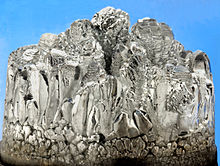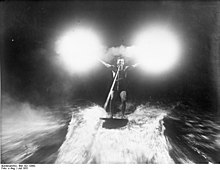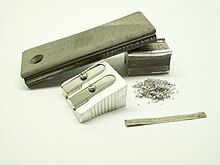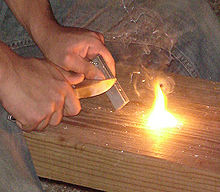Magnesium: Difference between revisions
m "commoness" changed to much less awkward "preponderance" in second sentence (because it is closest by dictionary definition) |
Amwyll Rwden (talk | contribs) m →History: added link |
||
| Line 68: | Line 68: | ||
The name originates from the [[Ancient Greek|Greek]] word for a district in [[Thessaly]] called [[Magnesia]]. It is related to [[magnetite]] and [[manganese]], which also originated from this area, and required differentiation as separate substances. See [[manganese]] for this history. |
The name originates from the [[Ancient Greek|Greek]] word for a district in [[Thessaly]] called [[Magnesia]]. It is related to [[magnetite]] and [[manganese]], which also originated from this area, and required differentiation as separate substances. See [[manganese]] for this history. |
||
Magnesium is the seventh most abundant element in the Earth's crust by mass and eighth by molarity.<ref name="Abundance">{{cite paper |title=Abundance and form of the most abundant elements in Earth’s continental crust |format=PDF |accessdate=2008-02-15 |url=http://www.gly.uga.edu/railsback/Fundamentals/ElementalAbundanceTableP.pdf}}</ref> It is found in large deposits of [[magnesite]], [[dolomite]], and other [[mineral]]s, and in mineral waters, where magnesium ion is soluble. In 1618 a farmer at Epsom in England attempted to give his cows water from a well. They refused to drink because of the water's bitter taste. However the farmer noticed that the water seemed to heal scratches and rashes. The fame of Epsom salts spread. Eventually they were recognized to be hydrated magnesium sulfate, MgSO<sub>4</sub>. |
Magnesium is the seventh most abundant element in the Earth's crust by mass and eighth by molarity.<ref name="Abundance">{{cite paper |title=Abundance and form of the most abundant elements in Earth’s continental crust |format=PDF |accessdate=2008-02-15 |url=http://www.gly.uga.edu/railsback/Fundamentals/ElementalAbundanceTableP.pdf}}</ref> It is found in large deposits of [[magnesite]], [[dolomite]], and other [[mineral]]s, and in mineral waters, where magnesium ion is soluble. In 1618 a farmer at Epsom in England attempted to give his cows water from a well. They refused to drink because of the water's bitter taste. However the farmer noticed that the water seemed to heal scratches and rashes. The fame of [[Magnesium sulfate|Epsom salts]] spread. Eventually they were recognized to be hydrated magnesium sulfate, MgSO<sub>4</sub>. |
||
The metal itself was first produced in England by Sir [[Humphry Davy]] in 1808 using electrolysis of a mixture of magnesia and [[mercury oxide]]. [[Antoine Bussy]] prepared it in coherent form in 1831. Davy's first suggestion for a name was magnium, but the name magnesium is now used. |
The metal itself was first produced in England by Sir [[Humphry Davy]] in 1808 using electrolysis of a mixture of magnesia and [[mercury oxide]]. [[Antoine Bussy]] prepared it in coherent form in 1831. Davy's first suggestion for a name was magnium, but the name magnesium is now used. |
||
Revision as of 13:17, 30 July 2009
 | ||||||||||||||||||||||||||
| Magnesium | ||||||||||||||||||||||||||
|---|---|---|---|---|---|---|---|---|---|---|---|---|---|---|---|---|---|---|---|---|---|---|---|---|---|---|
| Pronunciation | /mæɡˈniːziəm/ | |||||||||||||||||||||||||
| Appearance | shiny grey solid | |||||||||||||||||||||||||
| Standard atomic weight Ar°(Mg) | ||||||||||||||||||||||||||
| Magnesium in the periodic table | ||||||||||||||||||||||||||
| ||||||||||||||||||||||||||
| Atomic number (Z) | 12 | |||||||||||||||||||||||||
| Group | group 2 (alkaline earth metals) | |||||||||||||||||||||||||
| Period | period 3 | |||||||||||||||||||||||||
| Block | s-block | |||||||||||||||||||||||||
| Electron configuration | [Ne] 3s2 | |||||||||||||||||||||||||
| Electrons per shell | 2, 8, 2 | |||||||||||||||||||||||||
| Physical properties | ||||||||||||||||||||||||||
| Phase at STP | solid | |||||||||||||||||||||||||
| Melting point | 923 K (650 °C, 1202 °F) | |||||||||||||||||||||||||
| Boiling point | 1363 K (1091 °C, 1994 °F) | |||||||||||||||||||||||||
| Density (at 20° C) | 1.737 g/cm3[3] | |||||||||||||||||||||||||
| when liquid (at m.p.) | 1.584 g/cm3 | |||||||||||||||||||||||||
| Heat of fusion | 8.48 kJ/mol | |||||||||||||||||||||||||
| Heat of vaporization | 128 kJ/mol | |||||||||||||||||||||||||
| Molar heat capacity | 24.869[4] J/(mol·K) | |||||||||||||||||||||||||
Vapor pressure
| ||||||||||||||||||||||||||
| Atomic properties | ||||||||||||||||||||||||||
| Oxidation states | 0,[5] +1,[6] +2 (a strongly basic oxide) | |||||||||||||||||||||||||
| Electronegativity | Pauling scale: 1.31 | |||||||||||||||||||||||||
| Ionization energies |
| |||||||||||||||||||||||||
| Atomic radius | empirical: 160 pm | |||||||||||||||||||||||||
| Covalent radius | 141±7 pm | |||||||||||||||||||||||||
| Van der Waals radius | 173 pm | |||||||||||||||||||||||||
| Other properties | ||||||||||||||||||||||||||
| Natural occurrence | primordial | |||||||||||||||||||||||||
| Crystal structure | hexagonal close-packed (hcp) (hP2) | |||||||||||||||||||||||||
| Lattice constants | a = 320.91 pm c = 521.03 pm (at 20 °C)[3] | |||||||||||||||||||||||||
| Thermal expansion | 25.91×10−6/K (at 20 °C)[3][a] | |||||||||||||||||||||||||
| Thermal conductivity | 156[7] W/(m⋅K) | |||||||||||||||||||||||||
| Electrical resistivity | 43.9[8] nΩ⋅m (at 20 °C) | |||||||||||||||||||||||||
| Magnetic ordering | paramagnetic | |||||||||||||||||||||||||
| Molar magnetic susceptibility | +13.1×10−6 cm3/mol (298 K)[9] | |||||||||||||||||||||||||
| Young's modulus | 45 GPa | |||||||||||||||||||||||||
| Shear modulus | 17 GPa | |||||||||||||||||||||||||
| Bulk modulus | 35.4[10] GPa | |||||||||||||||||||||||||
| Speed of sound thin rod | 4940 m/s (at r.t.) (annealed) | |||||||||||||||||||||||||
| Poisson ratio | 0.290 | |||||||||||||||||||||||||
| Mohs hardness | 1–2.5 | |||||||||||||||||||||||||
| Brinell hardness | 44–260 MPa | |||||||||||||||||||||||||
| CAS Number | 7439-95-4 | |||||||||||||||||||||||||
| History | ||||||||||||||||||||||||||
| Naming | after Magnesia, Greece[11] | |||||||||||||||||||||||||
| Discovery | Joseph Black (1755[11]) | |||||||||||||||||||||||||
| First isolation | Humphry Davy (1808[11]) | |||||||||||||||||||||||||
| Isotopes of magnesium | ||||||||||||||||||||||||||
| ||||||||||||||||||||||||||
Magnesium (Template:Pron-en) is a chemical element with the symbol Mg, atomic number 12, atomic weight 24.3050 and common oxidation number +2.
Magnesium, an alkaline earth metal, is the ninth most abundant element in the universe by mass.[13] This preponderance of magnesium is related to the fact that it is easily built up in supernova stars from a sequential addition of three helium nuclei to carbon (which in turn is made from a single reaction between three helium nuclei at once). Magnesium constitutes about 2% of the Earth's crust by mass, which makes it the eighth most abundant element in the crust.[14] Magnesium ion's high solubility in water helps ensure that it is the third most abundant element dissolved in seawater.[15]
Magnesium is the 11th most abundant element by mass in the human body; its ions are essential to all living cells, where they play a major role in manipulating important biological polyphosphate compounds like ATP, DNA, and RNA. Hundreds of enzymes thus require magnesium ions in order to function. Magnesium is also the metallic ion at the center of chlorophyll, and is thus a common additive to fertilizers.[16] Magnesium compounds are used medicinally as common laxatives, antacids (i.e., milk of magnesia), and in a number of situations where stabilization of abnormal nerve excitation and blood vessel spasm is required (i.e., to treat eclampsia). Magnesium ions are sour to the taste, and in low concentrations help to impart a natural tartness to fresh mineral waters.
The free element (metal) is not found naturally on Earth, since it is highly reactive (though once produced, is coated in a thin layer of oxide—see passivation—which partly masks this reactivity). The free metal burns with a characteristic brilliant white light, making it a useful ingredient in flares. The metal is now mainly obtained by electrolysis of magnesium salts obtained from brine. Commercially, the chief use for the metal is as an alloying agent to make aluminium-magnesium alloys, sometimes called "magnalium" or "magnelium". Since magnesium is less dense than aluminum, these alloys are prized for their relative lightness and strength.
Notable characteristics
Elemental magnesium is a fairly strong, silvery-white, light-weight metal (two thirds the density of aluminium). It tarnishes slightly when exposed to air, although unlike the alkaline metals, storage in an oxygen-free environment is unnecessary because magnesium is protected by a thin layer of oxide which is fairly impermeable and hard to remove. Like its lower periodic table group neighbor calcium, magnesium reacts with water at room temperature, though it reacts much more slowly than calcium. When it is submerged in water, hydrogen bubbles will almost unnoticeably begin to form on the surface of the metal, though if powdered it will react much more rapidly. The reaction will occur faster with higher temperatures (see precautions). Magnesium also reacts exothermically with most acids, such as hydrochloric acid (HCl). As with aluminum, zinc and many other metals, the reaction with hydrochloric acid produces the chloride of the metal and releases hydrogen gas.
Magnesium is a highly flammable metal, but while it is easy to ignite when powdered or shaved into thin strips, it is difficult to ignite in mass or bulk. Once ignited, it is difficult to extinguish, being able to burn in both nitrogen (forming magnesium nitride), and carbon dioxide (forming magnesium oxide and carbon). On burning in air, magnesium produces a brilliant white light. Thus magnesium powder (flash powder) was used as a source of illumination in the early days of photography. Later, magnesium ribbon was used in electrically ignited flash bulbs. Magnesium powder is used in the manufacture of fireworks and marine flares where a brilliant white light is required. Flame temperatures of magnesium and magnesium alloys can reach 1,371 °C (2,500 °F), although flame height above the burning metal is usually less than 300 mm (12 in).[17]
Magnesium compounds are typically white crystals. Most are soluble in water, providing the sour-tasting magnesium ion Mg2+. Small amounts of dissolved magnesium ion contributes to the tartness and taste of natural waters. Magnesium ion in large amounts is an ionic laxative, and magnesium sulfate (Epsom salts) is sometimes used for this purpose. So-called "milk of magnesia" is a water suspension of one of the few insoluble magnesium compounds, magnesium hydroxide. The undissolved particles give rise to its appearance and name. Milk of magnesia is a mild base commonly used as an antacid.
Applications
As the metal

Magnesium is the third most commonly used structural metal, following steel and aluminium.
Magnesium compounds, primarily magnesium oxide (MgO), are used mainly as refractory material in furnace linings for producing iron, steel, nonferrous metals, glass and cement. Magnesium oxide and other compounds also are used in agricultural, chemical and construction industries. As a metal, this element's principal use is as an alloying additive to aluminium with these aluminium-magnesium alloys being used mainly for beverage cans.
Magnesium, in its purest form, can be compared with aluminium, and is strong and light, so it is used in several high volume part manufacturing applications, including automotive and truck components. Specialty, high-grade car wheels of magnesium alloy are called "mag wheels". In 1957 a Corvette SS, designed for racing, was constructed with magnesium body panels. An earlier Mercedes-Benz race car model, the Mercedes-Benz 300 SLR, had a body made from Elektron, a magnesium alloy; these cars ran (with successes) at Le Mans, the Mille Miglia, and other world-class race events in 1955 (though one was involved in the single worst accident in auto racing history, in terms of human casualties, at the Le Mans race.) Porsche's all-out quest to decrease the weight of their race cars led to the use of magnesium frames in the famous 917/053 which won Le Mans in 1971, and still holds the absolute distance record. The 917/30 Can-Am car also featured a magnesium spaceframe, helping it to make the most of its prodigious 1100-1500hp. Volkswagen has used magnesium in its engine components for many years. For a long time, Porsche used magnesium alloy for its engine blocks due to the weight advantage. There is renewed interest in magnesium engine blocks, as featured in the 2006 BMW 325i and 330i models. The BMW engine uses an aluminium alloy insert for the cylinder walls and cooling jackets surrounded by a high temperature magnesium alloy AJ62A. The application of magnesium AE44 alloy in the 2006 Corvette Z06 engine cradle has advanced the technology of designing robust automotive parts in magnesium. Both of these alloys are recent developments in high temperature low creep magnesium alloys. Mitsubishi Motors also uses magnesium (branded magnesium alloy) for its paddle shifters. The general strategy for such alloys is to form intermetallic precipitates at the grain boundaries, for example by adding mischmetal or calcium.[18] New alloy development and lower costs, which are becoming competitive to aluminium, will further the number of automotive applications.

The second application field of magnesium is electronic devices. Due to low weight, good mechanical and electrical properties, magnesium is widely used for manufacturing of mobile phones, laptop computers, cameras, and other electronic components.
Historically, magnesium was one of the main aerospace construction metals and was used for German military aircraft as early as World War I and extensively for German aircraft in World War II. The Germans coined the name 'Elektron' for magnesium alloy which is still used today. Due to perceived hazards with magnesium parts in the event of fire, the application of magnesium in the commercial aerospace industry was generally restricted to engine related components. Currently the use of magnesium alloys in aerospace is increasing, mostly driven by the increasing importance of fuel economy and the need to reduce weight. The development and testing of new magnesium alloys continues, notably Elektron 21 which has successfully undergone extensive aerospace testing for suitability in engine, internal and airframe components. The European Community runs three R&D magnesium projects in the Aerospace priority of Six Framework Program.

- Incendiary use: Magnesium is flammable, burning at a temperature of approximately 2500 K (2200 °C, 4000 °F), and the autoignition temperature of magnesium is approximately 744 K (473 °C, 883 °F) in air. The extremely high temperature at which magnesium burns makes it a handy tool for starting emergency fires during outdoor recreation. Other related uses include flashlight photography, flares, pyrotechnics, fireworks sparklers, and incendiary bombs.
Magnesium is also used:
- To remove sulfur from iron and steel.
- To refine titanium in the Kroll process.
- To photoengrave plates in the printing industry.
- To combine in alloys, where this metal is essential for airplane and missile construction.
- In the form of turnings or ribbons, to prepare Grignard reagents, which are useful in organic synthesis.
- As an alloying agent, improving the mechanical, fabrication and welding characteristics of aluminium.
- As an additive agent in conventional propellants and the production of nodular graphite in cast iron.
- As a reducing agent for the production of uranium and other metals from their salts.
- As a desiccant, since it easily reacts with water.
- As a sacrificial (galvanic) anode to protect underground tanks, pipelines, buried structures, and water heaters.
In magnesium compounds
- The magnesium ion is necessary for all life (see magnesium in biology), so magnesium salts are an additive for foods, fertilizers (Mg is a component of chlorophyll), and culture media.
- Magnesium hydroxide is used in milk of magnesia, its chloride, oxide, gluconate, malate, orotate and citrate used as oral magnesium supplements, and its sulfate (Epsom salts) for various purposes in medicine, and elsewhere (see the article for more). Oral magnesium supplements have been claimed to be therapeutic for some individuals who suffer from Restless Leg Syndrome (RLS). [citation needed]
- Magnesium borate, magnesium salicylate and magnesium sulfate are used as antiseptics.
- Magnesium bromide is used as a mild sedative (this action is due to the bromide, not the magnesium).
- Dead-burned magnesite is used for refractory purposes such as brick and liners in furnaces and converters.
- Magnesium carbonate (MgCO3) powder is also used by athletes, such as gymnasts and weightlifters, to improve the grip on objects – the apparatus or lifting bar.
- Magnesium stearate is a slightly flammable white powder with lubricative properties. In pharmaceutical technology it is used in the manufacturing of tablets, to prevent the tablets from sticking to the equipment during the tablet compression process (i.e., when the tablet's substance is pressed into tablet form).
- Magnesium sulfite is used in the manufacture of paper (sulfite process).
- Magnesium phosphate is used to fireproof wood for construction.
- Magnesium hexafluorosilicate is used in mothproofing of textiles.
History
The name originates from the Greek word for a district in Thessaly called Magnesia. It is related to magnetite and manganese, which also originated from this area, and required differentiation as separate substances. See manganese for this history.
Magnesium is the seventh most abundant element in the Earth's crust by mass and eighth by molarity.[14] It is found in large deposits of magnesite, dolomite, and other minerals, and in mineral waters, where magnesium ion is soluble. In 1618 a farmer at Epsom in England attempted to give his cows water from a well. They refused to drink because of the water's bitter taste. However the farmer noticed that the water seemed to heal scratches and rashes. The fame of Epsom salts spread. Eventually they were recognized to be hydrated magnesium sulfate, MgSO4.
The metal itself was first produced in England by Sir Humphry Davy in 1808 using electrolysis of a mixture of magnesia and mercury oxide. Antoine Bussy prepared it in coherent form in 1831. Davy's first suggestion for a name was magnium, but the name magnesium is now used.
Sources
Ores
Although magnesium is found in over 60 minerals, only dolomite, magnesite, brucite, carnallite, talc, and olivine are of commercial importance.
Sea water
The Mg2+
cation is the second most abundant cation in sea water (occurring at about 12% of the mass of sodium there), which makes sea water and sea-salt an attractive commercial source of Mg. To extract the magnesium, calcium hydroxide is added to sea water to form magnesium hydroxide precipitate.
- MgCl
2 + Ca(OH)
2 → Mg(OH)
2 + CaCl
2
Magnesium hydroxide is insoluble in water so it can be filtered out, and reacted with hydrochloric acid to obtain concentrated magnesium chloride.
- Mg(OH)
2 + 2 HCl → MgCl
2 + 2 H
2O
From magnesium chloride, electrolysis produces magnesium.
Electrolysis
In the United States, magnesium is principally obtained by electrolysis of fused magnesium chloride from brines, wells, and sea water. At the cathode, the Mg2+
ion is reduced by two electrons to magnesium metal:
- Mg2+
+ 2
e−
→ Mg
At the anode, each pair of Cl−
ions is oxidised to chlorine gas, releasing two electrons to complete the circuit:
- 2 Cl−
→ Cl
2 (g) + 2
e−
The United States has traditionally been the major world supplier of this metal, supplying 45% of world production even as recently as 1995. Today, the US market share is at 7%, with a single domestic producer left, US Magnesium, a company born from now-defunct Magcorp.[19]
As of 2005, China has taken over as the dominant supplier, pegged at 60% world market share, which increased from 4% in 1995. Unlike the above described electrolytic process, China is almost completely reliant on a different method of obtaining the metal from its ores, the silicothermic Pidgeon process (the reduction of the oxide at high temperatures with silicon).
Biological role
Due to the important interaction between phosphate and magnesium ions, magnesium ions are essential to the basic nucleic acid chemistry of life, and thus are essential to all cells of all known living organisms. Over 300 enzymes require the presence of magnesium ions for their catalytic action, including all enzymes utilizing or synthesizing ATP, or those which use other nucleotides to synthesize DNA and RNA. ATP exists in cells normally as a chelate of ATP and a magnesium ion.
Plants have an additional use for magnesium in that chlorophylls are magnesium-centered porphyrins. Magnesium deficiency in plants causes late-season yellowing between leaf veins, especially in older leaves, and can be corrected by applying Epsom salts (which is rapidly leached), or else crushed dolomitic limestone to the soil.

Magnesium is a vital component of a healthy human diet. Human magnesium deficiency (including conditions which show few overt symptoms) is relatively common, with only 32% of the United States meeting the RDA-DRI,[20] and has been implicated in the development of a number of human illnesses such as asthma, osteoporosis, and ADHD.[21]
Adult human bodies contain about 24 grams of magnesium, with 60% in the skeleton, 39% intracellular (20% in skeletal muscle), and 1% extracellular. Serum levels are typically 0.7 – 1.0 mmol/L. Serum magnesium levels may appear normal even in cases of underlying intracellular deficiency, although no known mechanism maintains a homeostatic level in the blood other than renal excretion of high blood levels. Intracellular magnesium is correlated with intracellular potassium. Magnesium is absorbed in the gastrointestinal tract, with more absorbed when status is lower. In humans, magnesium appears to facilitate calcium absorption. Low and high protein intake inhibit magnesium absorption, and other factors such as phosphate, phytate, and fat affect absorption. Absorbed dietary magnesium is largely excreted through the urine, although most magnesium "administered orally" is excreted through the feces.[22] Magnesium status may be assessed roughly through serum and erythrocyte Mg concentrations and urinary and fecal excretion, but intravenous magnesium loading tests are likely the most accurate and practical in most people.[23] In these tests, magnesium is injected intravenously; a retention of 20% or more indicates deficiency.[24] Other nutrient deficiencies are identified through biomarkers, but none are established for magnesium.[25]
Spices, nuts, cereals, coffee, cocoa, tea, and vegetables (especially green leafy ones) are rich sources of magnesium. Observations of reduced dietary magnesium intake in modern Western countries as compared to earlier generations may be related to food refining and modern fertilizers which contain no magnesium.[22]
There are a number of magnesium dietary supplements available. Magnesium oxide, one of the most common because it has a high magnesium content per weight, has been reported to be the least bioavailable.[26][27] Magnesium citrate has been reported as more bioavailable than oxide or amino-acid chelate (glycinate) forms.[28]
Excess magnesium in the blood is freely filtered at the kidneys, and for this reason it is difficult to overdose on magnesium from dietary sources alone.[21] With supplements, overdose is possible, however, particularly in people with poor renal function; occasionally, with use of high cathartic doses of magnesium salts, severe hypermagnesemia has been reported to occur even without renal dysfunction.[29] Alcoholism can produce a magnesium deficiency which is easily reversed by oral or parenteral administration, depending on the degree of deficiency.[30]
Isotopes
Magnesium has three stable isotopes: 24Mg, 25Mg, 26Mg. All are present in significant amounts (see table of isotopes above). About 79% of Mg is 24Mg. The isotope 28Mg is radioactive and in the 1950s to 1970s was made commercially by several nuclear power plants for use in scientific experiments. This isotope has a relatively short half-life (21 hours) and so its use was limited by shipping times.
26Mg has found application in isotopic geology, similar to that of aluminium. 26Mg is a radiogenic daughter product of 26Al, which has a half-life of 717,000 years. Large enrichments of stable 26Mg have been observed in the Ca-Al-rich inclusions of some carbonaceous chondrite meteorites. The anomalous abundance of 26Mg is attributed to the decay of its parent 26Al in the inclusions. Therefore, the meteorite must have formed in the solar nebula before the 26Al had decayed. Hence, these fragments are among the oldest objects in the solar system and have preserved information about its early history.
It is conventional to plot 26Mg/24Mg against an Al/Mg ratio. In an isochron dating plot, the Al/Mg ratio plotted is27Al/24Mg. The slope of the isochron has no age significance, but indicates the initial 26Al/27Al ratio in the sample at the time when the systems were separated from a common reservoir.
Precautions

Magnesium metal and its alloys are explosive hazards; they are highly flammable in their pure form when molten or in powder or in ribbon form. Burning or molten magnesium metal reacts violently with water. When working with powdered magnesium, safety glasses with welding eye protection are employed, because the bright white light produced by burning magnesium contains ultraviolet light that can permanently damage the retinas of the eyes.[31]
Magnesium is capable of reducing water to the highly-flammable hydrogen gas:[32]
- Mg (s) + 2 H
2O → Mg(OH)
2 (s) + H
2 (g)
As a result, water cannot be used to extinguish magnesium fires; the hydrogen gas produced will only intensify the fire.
Magnesium also reacts with carbon dioxide to form magnesium oxide and carbon:
- 2 Mg (s) + CO
2 → 2 MgO (s) + C (s)
Hence, carbon dioxide fire extinguishers cannot be used for extinguishing magnesium fires either.[33]
Burning magnesium is usually quenched by using a Class D dry chemical fire extinguisher, or by covering the fire with sand or magnesium foundry flux to remove its air source.
References
- ^ "Standard Atomic Weights: Magnesium". CIAAW. 2011.
- ^ Prohaska, Thomas; Irrgeher, Johanna; Benefield, Jacqueline; Böhlke, John K.; Chesson, Lesley A.; Coplen, Tyler B.; Ding, Tiping; Dunn, Philip J. H.; Gröning, Manfred; Holden, Norman E.; Meijer, Harro A. J. (2022-05-04). "Standard atomic weights of the elements 2021 (IUPAC Technical Report)". Pure and Applied Chemistry. doi:10.1515/pac-2019-0603. ISSN 1365-3075.
- ^ a b c d Arblaster, John W. (2018). Selected Values of the Crystallographic Properties of Elements. Materials Park, Ohio: ASM International. ISBN 978-1-62708-155-9.
- ^ Rumble, p. 4.61
- ^ Mg(0) has been synthesized in a compound containing a Na2Mg22+ cluster coordinated to a bulky organic ligand; see Rösch, B.; Gentner, T. X.; Eyselein, J.; Langer, J.; Elsen, H.; Li, W.; Harder, S. (2021). "Strongly reducing magnesium(0) complexes". Nature. 592 (7856): 717–721. Bibcode:2021Natur.592..717R. doi:10.1038/s41586-021-03401-w. PMID 33911274. S2CID 233447380
- ^ Bernath, P. F.; Black, J. H. & Brault, J. W. (1985). "The spectrum of magnesium hydride" (PDF). Astrophysical Journal. 298: 375. Bibcode:1985ApJ...298..375B. doi:10.1086/163620.. See also Low valent magnesium compounds.
- ^ Rumble, p. 12.137
- ^ Rumble, p. 12.28
- ^ Rumble, p. 4.70
- ^ Gschneider, K. A. (1964). Physical Properties and Interrelationships of Metallic and Semimetallic Elements. Solid State Physics. Vol. 16. p. 308. doi:10.1016/S0081-1947(08)60518-4. ISBN 9780126077162.
- ^ a b c Rumble, p. 4.19
- ^ Kondev, F. G.; Wang, M.; Huang, W. J.; Naimi, S.; Audi, G. (2021). "The NUBASE2020 evaluation of nuclear properties" (PDF). Chinese Physics C. 45 (3): 030001. doi:10.1088/1674-1137/abddae.
- ^ Ash, Russell (2005), The Top 10 of Everything 2006: The Ultimate Book of Lists, Dk Pub, ISBN 0756613213.
- ^ a b "Abundance and form of the most abundant elements in Earth's continental crust" (PDF). Retrieved 2008-02-15.
{{cite journal}}: Cite journal requires|journal=(help) - ^ http://www.seafriends.org.nz/oceano/seawater.htm#composition. Retrieved Jan. 20, 2009
- ^ http://www.mg12.info
{{citation}}: Missing or empty|title=(help) - ^ DOE Handbook - Primer on Spontaneous Heating and Pyrophoricity. U.S. Department of Energy. December 1994. p. 20. DOE-HDBK-1081-94.
- ^ Alan A. Luo and Bob R. Powell (2001). "Tensile and Compressive Creep of Magnesium-Aluminum-Calcium Based Alloys" (PDF). Materials & Processes Laboratory, General Motors Research & Development Center. Retrieved 2007-08-21.
{{cite journal}}: Cite journal requires|journal=(help) - ^ Vardi, Nathan (February 22 2007). "Man With Many Enemies". Forbes.com. Retrieved 2006-06-26.
{{cite web}}: Check date values in:|date=(help) - ^ "Lack Energy? Maybe It's Your Magnesium Level". United States Department of Agriculture. Retrieved 2008-09-18. Last paragraph
- ^ a b University of Maryland Medical Center. Magnesium
- ^ a b Wester PO (1987). "Magnesium". Am. J. Clin. Nutr. 45 (5 Suppl): 1305–12. PMID 3578120.
{{cite journal}}: Unknown parameter|month=ignored (help) - ^ Arnaud MJ (2008). "Update on the assessment of magnesium status". Br. J. Nutr. 99 Suppl 3: S24–36. doi:10.1017/S000711450800682X. PMID 18598586.
{{cite journal}}: Unknown parameter|month=ignored (help) - ^ Rob PM, Dick K, Bley N; et al. (1999). "Can one really measure magnesium deficiency using the short-term magnesium loading test?". J. Intern. Med. 246 (4): 373–8. doi:10.1046/j.1365-2796.1999.00580.x. PMID 10583708.
{{cite journal}}: Explicit use of et al. in:|author=(help); Unknown parameter|month=ignored (help)CS1 maint: multiple names: authors list (link) - ^ Franz KB (2004). "A functional biological marker is needed for diagnosing magnesium deficiency". J Am Coll Nutr. 23 (6): 738S–41S. PMID 15637224.
{{cite journal}}: Unknown parameter|month=ignored (help) - ^ Firoz M, Graber M (2001). "Bioavailability of US commercial magnesium preparations". Magnes Res. 14 (4): 257–62. PMID 11794633.
{{cite journal}}: Unknown parameter|month=ignored (help) - ^ Lindberg JS, Zobitz MM, Poindexter JR, Pak CY (1990). "Magnesium bioavailability from magnesium citrate and magnesium oxide". J Am Coll Nutr. 9 (1): 48–55. PMID 2407766.
{{cite journal}}: Unknown parameter|month=ignored (help)CS1 maint: multiple names: authors list (link) - ^ Walker AF, Marakis G, Christie S, Byng M (2003). "Mg citrate found more bioavailable than other Mg preparations in a randomised, double-blind study". Magnes Res. 16 (3): 183–91. PMID 14596323.
{{cite journal}}: Unknown parameter|month=ignored (help)CS1 maint: multiple names: authors list (link) - ^ Kontani M, Hara A, Ohta S, Ikeda T (2005). "Hypermagnesemia induced by massive cathartic ingestion in an elderly woman without pre-existing renal dysfunction". Intern. Med. 44 (5): 448–52. doi:10.2169/internalmedicine.44.448. PMID 15942092.
{{cite journal}}: CS1 maint: multiple names: authors list (link) - ^ AJ Giannini. Drugs of Abuse--Second Edition. Los Angeles, Physicians Management Information Co., 1997.
- ^ "Science Safety: Chapter 8". Government of Manitoba. Retrieved 2007-08-21.
- ^ "Chemistry : Periodic Table : magnesium : chemical reaction data". webelements.com. Retrieved 2006-06-26.
- ^ "Demo Lab: Reaction Of Magnesium Metal With Carbon Dioxide". Retrieved 2006-06-26.
External links
- WebElements.com – Magnesium
- Online Resource for industry professionals - Magnesium.com
- The Magnesium Website – Includes full text papers and textbook chapters by leading magnesium authorities Mildred Seelig, Jean Durlach, Burton M. Altura and Bella T. Altura. Links to over 300 articles discussing magnesium and magnesium deficiency.
- Magnesium in Health - Mg12.info
Cite error: There are <ref group=lower-alpha> tags or {{efn}} templates on this page, but the references will not show without a {{reflist|group=lower-alpha}} template or {{notelist}} template (see the help page).

